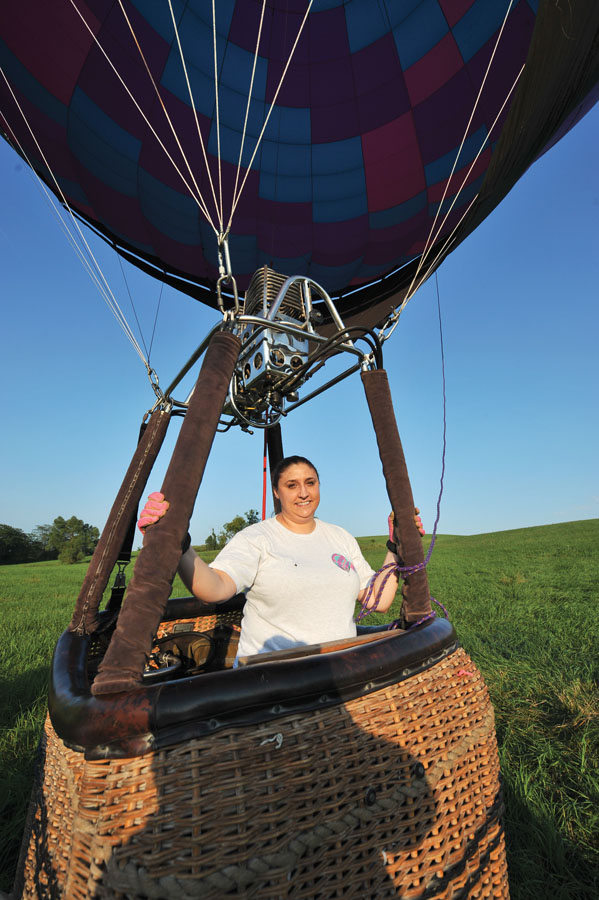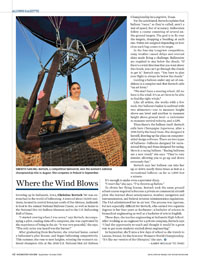Alumni Gazette
 SMOOTH SAILING: Bertsch, a competitive balloonist, won the women’s national championship title in August. She competes in Poland in September. (Photo: Steve Pope/AP Images for Rochester Review)
SMOOTH SAILING: Bertsch, a competitive balloonist, won the women’s national championship title in August. She competes in Poland in September. (Photo: Steve Pope/AP Images for Rochester Review)Growing up in Indianola, Iowa, Christine Bertsch ’00 was entrenched in the world of ballooning. A town of about 15,000 residents, located in central Iowa just south of Des Moines, Indianola is host to the annual National Balloon Classic, as well as home to the National Hot Air Balloon Museum and to the U.S. Ballooning Hall of Fame.
“I started crewing when I was seven,” says Bertsch. Accompanying a pilot, reading data off a computer, she was captivated by the experience of being in the air. “It was very peaceful,” she says. “The only noise you heard was the burner.”
After graduating from Rochester, she returned home, earned a balloonist’s pilot license, and began ballooning competitively. This summer, she rose to new heights, winning the women’s national champion title at the 2014 U.S. National Hot Air Balloon Championship in Longview, Texas.
For the uninitiated, Bertsch explains that balloon “races,” as they’re called, aren’t a test of speed, but of accuracy. Balloonists follow a course consisting of several on-the-ground targets. The goal is to fly over the targets, dropping a beanbag at each one. Points are assigned depending on how close each bag comes to its target.
In the four-day Longview competition, rainy weather caused delays and overcast skies made flying a challenge. Balloonists are required to stay below the clouds. “If there’s a wind direction that you want above the clouds, you can’t go through the clouds to get it,” Bertsch says. “You have to plan your flight to always be below the clouds.”
Guiding a balloon under any set of conditions is a complex task that Bertsch calls “an art form.”
“We don’t have a steering wheel. All we have is the wind. It’s an art form to be able to find the right winds.”
Like all artists, she works with a few tools. Her balloon’s basket is outfitted with two altimeters—one to measure height above sea level and another to measure height above ground level—a variometer to measure vertical velocity, and a GPS.
Then there’s the balloon itself. Bertsch calls hers Champagne Supernova, after a 1996 hit by the band Oasis.
She designed it herself, drawing up the plans on computer-aided design software. There are two types of balloons—balloons designed for recreational flying and those designed for racing. Hers is a racing balloon. “Racing balloons are a new trend,” she says. “They’re very slender, allowing you to go up and down extremely fast.”
Bertsch says her balloon can take her up or down nearly three times as fast as a recreational balloon—as far as 1,800 feet a minute.
It’s enough to make even a spectator dizzy.
“I won’t lie,” she says. “I’ve thrown up before.”
To obtain her flying license, Bertsch took the same ground school course required to become a private or commercial aircraft pilot. She learned about aerodynamics, weather, navigation and instrumentation, and Federal Aviation Administration regulations. The FAA administered her in-air test.
The process was rigorous, but not especially difficult for Bertsch, who earned two separate degrees in her four years at Rochester—a bachelor of science in biomedical engineering as well as a bachelor of arts in English.
These days, she teaches engineering at Indianola High School. After working as an engineer for a private company, Bertsch says “I had the opportunity to teach and thought it would be a great way to get more students excited about engineering.”
In September, she’ll miss a few days of school as she travels to Leszno, Poland, for the first ever Women’s World Championship. “It’s like our version of the Olympics,” she says. r
—Karen McCally ’02 (PhD)

